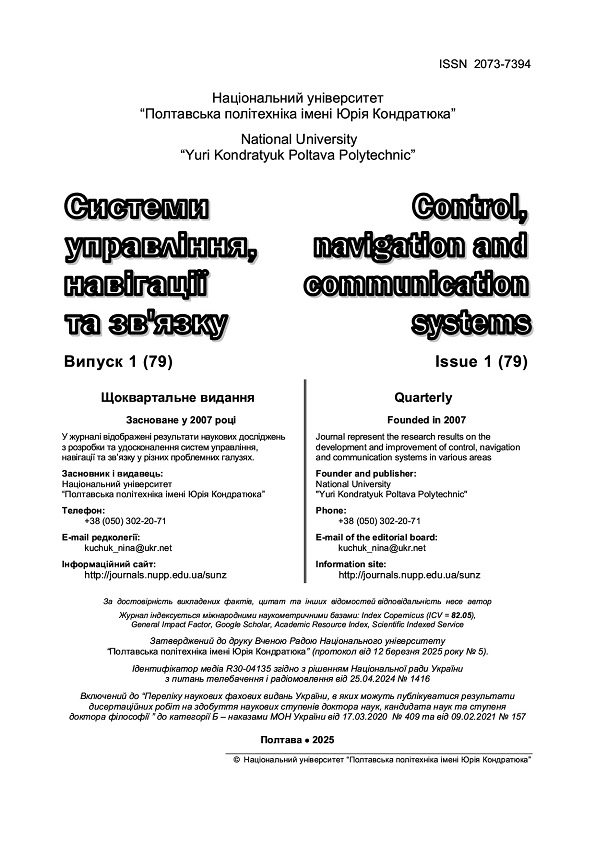MODEL DEVELOPMENT OF DYNAMIC REPRESENTATION A MODEL DESCRIPTION PARAMETERS FOR THE ENVIRONMENT OF A COLLABORATIVE ROBOT MANIPULATOR WITHIN THE INDUSTRY 5.0 FRAMEWORK
DOI:
https://doi.org/10.26906/SUNZ.2025.1.42-48Keywords:
collaborative robot, dynamic representation, environmental model, Industry 5.0, sensor systems, robot manipulator, collaboration security, automation, adaptability, cyber manufacturing systemsAbstract
The article presents a study on the development of a model for the dynamic representation the environmental
description parameters for a collaborative robot manipulator within the Industry 5.0 requirements. The main focus is a
mathematical model that allows the robot to quickly adapt to changes in the workspace, ensuring effective and safe interaction
with humans. The proposed model takes into account data from various sensor systems, such as lidars, cameras, and ultrasonic
sensors, to continuously update information about the environment. The study also considers algorithms that optimize the process
of data collection and processing to improve the accuracy of prediction and response of the robot. The results of the work are
aimed at increasing the efficiency of collaborative robots in production environments, improving the level of automation and
ensuring harmonious cooperation between humans and machines within modern cyber manufacturing systems.
Downloads
References
1. Rahman, M. M., Khatun, F., Jahan, I., Devnath, R., & Bhuiyan, M. A. A. (2024). Cobotics: The Evolving Roles and Prospects of Next‐Generation Collaborative Robots in Industry 5.0. Journal of Robotics, 2024(1), 2918089. DOI: https://doi.org/10.1155/2024/2918089
2. Gurin, D., Yevsieiev, V., Maksymova, S., & Abu-Jassar, A. (2024). Effect of Frame Processing Frequency on Object Identification Using MobileNetV2 Neural Network for a Mobile Robot. Multidisciplinary Journal of Science and Technology, 4(8), 36-44.
3. Palácios, R.H.C., Bertoncini, J.P.S., Uliam, G.H.O. et al. Evaluation of mobile autonomous robot in trajectory optimization. Computing 105, 2725–2745 (2023). https://doi.org/10.1007/s00607-023-01205-6 DOI: https://doi.org/10.1007/s00607-023-01205-6
4. Yevsieiev, V., & Gurin, D. (2023). Comparative Analysis of the Characteristics of Mobile Robots and Collaboration Robots Within INDUSTRY 5.0 (Doctoral dissertation, European Scientific Platform).
5. Holzinger, A., Schweier, J., Gollob, C. et al. From Industry 5.0 to Forestry 5.0: Bridging the gap with Human-Centered Artificial Intelligence. Curr. For. Rep. (2024). https://doi.org/10.1007/s40725-024-00231-7 DOI: https://doi.org/10.1007/s40725-024-00231-7
6. Zafar, M. H., Langås, E. F., & Sanfilippo, F. (2024). Exploring the synergies between collaborative robotics, digital twins, augmentation, and industry 5.0 for smart manufacturing: A state-of-the-art review. Robotics and Computer-Integrated Manufacturing, 89, 102769. DOI: https://doi.org/10.1016/j.rcim.2024.102769
7. Gurin, D., Yevsieiev, V., Maksymova, S., & Alkhalaileh, A. (2024). Using Convolutional Neural Networks to Analyze and Detect Key Points of Objects in Image. Multidisciplinary Journal of Science and Technology, 4(9), 5-15.
8. Bhat, F.A., Parvez, S. Emerging Challenges in the Sustainable Manufacturing System: From Industry 4.0 to Industry 5.0. J. Inst. Eng. India Ser. C (2024). https://doi.org/10.1007/s40032-024-01046-y DOI: https://doi.org/10.1007/s40032-024-01046-y
9. Mahmud, S., Kamarulariffin, A., Ibrahim, A.M. et al. Advancements and Challenges in Mobile Robot Navigation: A Comprehensive Review of Algorithms and Potential for Self-Learning Approaches. J Intell Robot Syst 110, 120 (2024).https://doi.org/10.1007/s10846-024-02149-5 DOI: https://doi.org/10.1007/s10846-024-02149-5
Downloads
Published
Issue
Section
License

This work is licensed under a Creative Commons Attribution-NonCommercial 4.0 International License.




